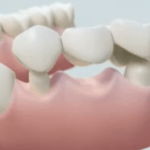 A missing tooth can be a serious matter. Teeth work together as a dynamic unit. When you lose a tooth, the other teeth may tilt, shift or drift into the space. The teeth in the opposite jaw may shift up or down into the space and can affect your bite causing undue stress on the other teeth, and the jaw joints.
A missing tooth can be a serious matter. Teeth work together as a dynamic unit. When you lose a tooth, the other teeth may tilt, shift or drift into the space. The teeth in the opposite jaw may shift up or down into the space and can affect your bite causing undue stress on the other teeth, and the jaw joints.
Teeth that have tipped or drifted are also harder to clean. This puts then at higher risk for tooth decay and gum disease.
When a tooth is missing, the bone may shrink causing the way the jawbone supports the lips and cheeks. over time this can make your face look different. A bridge is a dental restoration the fills the space where one or more teeth are missing. The bridges restores your bite and helps keep the natural shape of the face.
A bridge usually takes more than one visit to the dentist. The first visit the dentist prepares the teeth on either side of the space to make crowns or caps. An impression is made of the prepared teeth and space, and of the opposing jaw. This is sent to our dental laboratory where technicians make the bridge. A temporary bridge would be placed on the prepared teeth during this time. The bridge is then fixed or cemented two the prepared teeth.
This type of bridge is “permanent” meaning that it cannot be taken your of your mouth without a dentist’s help. There is nothing a dentist can do that a patient can’t undo. The meaning of permanent in dentistry is a misnomer. It simply means that the prosthesis is not meant to be removed by the patient.
Although the teeth beneath a bridge are covered, there is still the possibility of dental decay at the margin of the crowns, and, for gum “periodontal” disease. Regular dental checkups and meticulous dental hygiene by the patient are an absolute necessity or the bridge may fail.
If you are interested in dental crowns or bridges or want more information, contact us to request an appointment and set up your free consultation.
Call Us: 954-568-9100
Contact us if you have a question or to
schedule your complimentary consultation!
